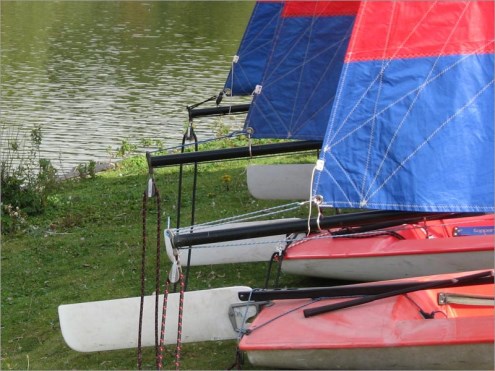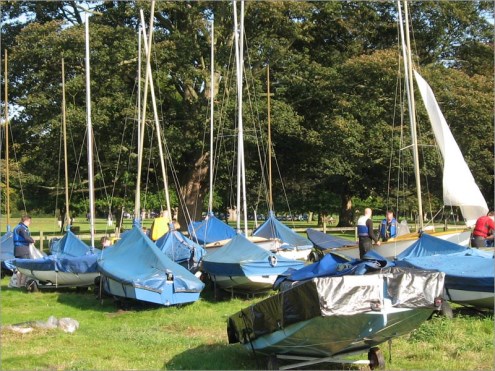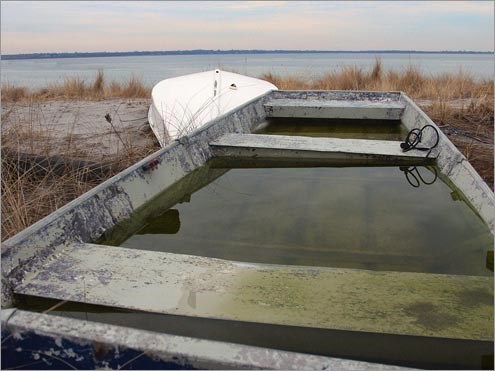Join a Sailing Club
Go To: Sailing - Learn To Sail
Posted on 08 October 2007 00:00
The best way to start! Find out how to join a club in your area.
So, you want to join a sailing club. How do you go about it? Well first, you need to ask yourself what kind of club do you want to join, and what you want to do when you join.
If you are just learning to sail, then you would probably be best off looking for inland clubs rather than coastal, unless you enjoy a challenge? On an inland club, on a lake or reservoir, you don't have to contend with difficult tides or sea breezes (unless you're close to the sea), which makes the early days of sailing, which are the hardest, easier. Also, lakes can tend to be warmer and less dangerous than the sea, when you capsize. Plus, no waves, (other than choppiness generated by the wind)!

Photo 1: Would you prefer to sail on a small puddle, or the sea?
If you have some experience or a lot of guts, then by all means look for coastal clubs. Bear in mind however, that some coastal sailing clubs are exclusively yacht clubs, and this will determine which clubs you can look at; some clubs operate yacht and dinghy class sailing, whilst some yacht clubs can be exclusively for yachts and won't allow dinghy sailing to take place within their bounds of operation. Of course, if you are interested in yacht sailing, you will be restricted to pretty much solely coastal clubs; some larger reservoirs and rivers have limited power boat and small keelboat sailing, but rarely do they operate larger keel boats or yachts (other than sports boats such as the Laser SB3 or the Stratos, but again this is rare).
If you want to learn to sail, not all clubs operate training schemes; our sailing club directory lists clubs which operate RYA training centres, although this list is changing all the time, and only the RYA have a full up to date list - there is a booklet available from them which contains this list. Also to bear in mind when learning to sail is if the club operates a safety boat, which whilst running a training course they are legally bound to do so, however they may not at all times while boats are on the water. Bala in mid-Wales is an example of this; a 4 mile long, half mile wide lake, Bala has two sailing clubs, a sailing club and a catamaran club, although sailing is allowed at any time since the water is owned by the Snowdonia estate; however, don't expect a safety boat to be out when the club isn't operating an event or general sailing. Even when you are experienced, going out on a large lake in choppy conditions without that extra safety net so to speak can be a daunting prospect.

Photo 2: Does the club run training schemes?
When looking for a club to sail at, whether you are learning to sail or are already competent at sailing, there are several things to bear in mind when searching around. Make sure, first and foremost, that the club you are looking at has good access to the lake; if you have to drag a boat and trailer across 200 metres of field before reaching the lake, you'll be too tired to sail before you even start! The majority of clubs will have good access; some even let you park up on a field next to the lake to rig up, and dinghy parks are usually located at waters edge.

Photo 3: Remember to check out dinghy park facilities
You should bear in mind launching facilities; if you are only used to launching from a ramp, if a club has only pontoons to launch on, you may find it awkward at first and may wish to look elsewhere. If you have a particularly heavy boat, clubs with a winch would have an obvious benefit, or simply a larger club where there are likely to be more people around at any time to lend a hand. Some clubs or centres even have tractors that you can use to tow your boat to the water, particularly appropriate in tidal areas such as coastal or estuary based clubs.
At the same time, check out the dinghy park. If a club has a tidy, well kept dinghy park, it's a good sign they have pride in their park, and in turn pride in their club. Don't be worried if you find the odd old wooden boat falling apart in the corner - it may well have been bought by a member for a do-up project. Do be worried if there are numbers of old boats lying around, falling apart, without covers, rusting, full of water, overgrown by weeds, and just generally over untidy. Remember that many people can only afford to buy older second hand boats, for example many lasers still doing the rounds were actually built in the 80s, and certainly won't brand new - don't confuse a few patches of deck crazing and bumps and scrapes on a boat for poor maintenance, instead look for bigger things, such as boats with cracked hulls, rubbish lying around, and so on. Basically, use your common sense!

Photo 4: Lots of wrecked dinghies lying around is not a good sign
Any sailing club worth it's sea salt will have changing rooms, and we'd question the sanity of anyone joining a club which didn't have changing rooms and hot showers, since hypothermia is a serious thing! Some go one step further and have dry rooms (for drying out wetsuits, drysuits and the like), or even wet areas such as a cafe so you can get a bite to eat without changing between races.
Larger sailing clubs, such as Grafham Water have on-site shops, ranging from cafe's to small chandleries - very handy when a crucial part of your rigging snaps just before the last deciding race of the day! This does tend to be the exception though, rather than the norm.
Security may be an issue; some clubs, particularly larger ones, are too far out of the way to attract too much trouble, such as Chelmarsh Sailing Club in Shropshire, but smaller inner city or clubs neared urban areas, can often be targeted by vandals, who have no particular reason for smashing boats and throwing them in the water other than the fact that they can. Most clubs will require you to at least chain down your boat, often to a chain running the length of the boat park, but others, such as Midland Sailing Club may even have complete locked storage for boats and not store many outside at all, which is the only way to be sure. From a different point of view, coastal sailing clubs have a similar problem of potential damage from a different source; in bad weather, if boats are stored outside by the water, there's a chance rough seas or high tides could damage boats, and some have measures in place to prevent this. Take this into consideration when looking around - you don't want to spend several thousand pounds on a shiny new boat to have it lifted off its trailer and smashed back down holing the hull by rough seas.
If you can sail and racing is the main highlight rather than cruising, then check out the clubs racing and events calendar. Some smaller clubs may only do limited races several times a year and just open cruising (free sailing) the rest of the time, whereas a club that has races on Sundays, Wednesday evenings and holds Nationals and Worlds may be more suited to you. Bear in mind that if you come from an inland racing club, there is a huge difference when moving to the open sea if you have not done it before, taking on tides, waves and different wind situations. Make sure everythings to your liking first.

Photo 5: Check the race schedule if it's something you're interested in
Some clubs will let you go along and sail as a visitor, or as a guest of a member before you join, although you may have to pay a small amount to do this. If you are interested in a club that does allow this, then by all means take them up - not only can you get a feel for the club, the water, the wind, you can also start getting a feel for some of the members, and whether or not you'd fit in.
It can be quite expensive joining a sailing club - prices range from £5 to upwards of £800 for some of the more exclusive clubs, although the average does tend to be around the £100 to £200 range, once you take into account water fees and dinghy park fees if applicable. Since you're going to be paying out this amount of money to spend probably a fair amount of your free time each year (and donate even more time if you get involved heavily with volunteering, training and committees), it makes sense to shop around. Hopefully some of the tips above will make the decision process a little easier!